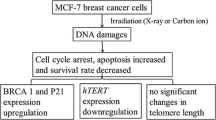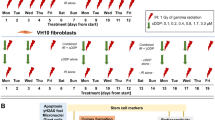Aim:
The effect of ionizing irradiation on telomerase activity and further associated biological factors was evaluated in a human Ewing tumor xenograft model on nude mice.
Material and Methods: The human Ewing tumor cell line STA-ET-1 was established in a nude mouse model. Initially, the dose-response relationship for the tumor model was established. For the radiation experiments two dose levels were chosen: 5 Gy and 30 Gy. After 5 Gy, there was no significant growth delay whereas after 30 Gy there was a marked growth delay without the induction of a complete remission. Tumors were examinated 6, 12, 24, 48, 72, and 96 hours post irradiation. After irradiation with 30 Gy further time points were 6, 9, 12 and 15 days. For each dose and time group, three tumors were evaluated.
Results: There was a reduction of telomerase activity after 5 Gy to 50% (not statistically significant) after 3 days; however, after 30 Gy there was a reduction of telomerase activity to 23% of the initial value after 6 days (p = 0.001). Telomerase activity correlated with the expression of human telomerase reverse transcriptase (hTERT), but not with the expression of telomerase-associated protein (TP1) and human telomerase RNA (hTR). The maximal amounts of necrisis or apoptosis after 30 Gy were 19% and 6.9%, respectively.
Conclusions: Ionizing radiation reduces telomerase activity and the expression of hTERT which cannot be explained by the induction of necrosis or apoptosis alone. The reduction of telomerase activity may contribute to delayed cell death after radiotherapy. The combined use of radiation and specific telomerase inhibitors may be a potentially synergistic treatment strategy.
Ziel:
Die Wirkung von ionisierender Strahlung auf die Telomeraseaktivität und weiterer assoziierter biologischer Parameter wurde an einem humanen Ewing-Tumor-Xenograft-Modell auf der Nacktmaus untersucht.
Material und Methode: Die humane Ewing-Tumor-Zelllinie STA-ET-1 wurde auf der Nacktmaus etabliert. Zuerst wurde die Dosis-Wirkungs-Beziehung für den Tumor etabliert. Für die Bestrahlungsexperimente wurden zwei Bestrahlungsdosen gewählt: 5 Gy und 30 Gy. Nach 5 Gy wurde keine Wachstumsverzögerung beobachtet, nach 30 Gy trat eine deutliche Wachstumsverzögerung auf, ohne eine komplette Remission zu induzieren. Die Tumoren wurden 6, 12, 24, 48, 72 und 96 Stunden nach Bestrahlung untersucht. Nach 30 Gy wurden zusätzliche Zeitpunkte nach 6, 9, 12 und 15 Tagen gewählt. Für jede Dosis- und Zeitgruppe wurden drei Tumoren untersucht.
Ergebnisse: Nach 5 Gy kam es zu einer statistisch nicht signifikanten Reduktion der Telomeraseaktivität auf 50% nach 3 Tagen (Abbildung 3a). Nach 30 Gy war die Telomerasekativität nach 6 Tagen auf 23% reduziert (p = 0.001, Abbildung 4a). Die Telomeraseaktivität korrelierte mit der Expression von hTERT (Human Telomerase Reverse Transcriptase, Abbildungen 3b und 4b), nicht jedoch mit der Expression von TP1 (Telomerase-assoziiertes Protein) und hTR (Human Telomerase RNA). Der maximale Nekrose- und Apoptoseanteil betrug 19% und 6,9% (Abbildung 6).
Schlussfolgerungen: Ionisierende Strahlung reduziert die Expression von hTERT und Telomeraseaktivität. Diese Reduktion ist nicht allein auf die Induktion von Apoptose oder Nekrose zurückzuführen. Die Reduktion der Telomeraseaktivität kann zu einem verzögerten Zelluntergang nach Bestrahlung beitragen. Die kombinierte Verwendung von Bestrahlung und spezifischen Telomeraseinhibitoren ist ein potentiell synergistischer Therapieansatz.
Similar content being viewed by others
Author information
Authors and Affiliations
Additional information
Received: January 16, 2002; accepted: May 16, 2002
Correspondence Address Dr. Andreas Schuck, Klinik für Strahlentherapie – Radioonkologie, Universitätsklinikum, Albert-Schweitzer-Straße 33, 48129 Münster, Germany, Phone (+49/251) 8347-384, Fax -355, e-mail: schuck@uni-muenster.de
Rights and permissions
About this article
Cite this article
Schuck, A., Poremba, C., Lanvers, C. et al. Radiation-Induced Changes of Telomerase Activity in a Human Ewing Xenograft Tumor. Strahlenther Onkol 178, 701–708 (2002). https://doi.org/10.1007/s00066-002-0992-x
Issue Date:
DOI: https://doi.org/10.1007/s00066-002-0992-x




